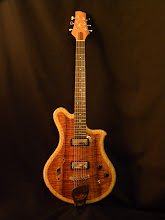This question has been coming up a lot lately, So I thought it might be an interesting subject for a blog post.
It's impossible to have a discussion about Fanned Frets with out mentioning Ralph Novak of Novax guitars. He is singlehandedly responsible for developing and implementing the Fanned Fret system.
Ralph introduced me to the idea when I went to work for him in the fall of 2001. I must admit I was a skeptic at first, but the more I worked on his instruments, the more I could see real benefits. By the end of my time at Novax I was hooked. So here's the theory behind the Fanned Fret system. I've done my best to explain it in simple terms which everyone can understand, but for those who must have charts and graph here's a link to Ralph Novak's site. http://www.novaxguitars.com/info/concept.html
None of us liked physics anyway...Am I right? So here we go...
If you look at a piano or a harp, the bass strings are larger and much longer than the treble strings. The reason for this is that the lower a pitch or note, the larger a string needs to be to sustain it. However, as the mass of a string increases so does the length needed to develop its full harmonic range. This is why the strings on a bass are bigger and longer than those of a regular guitar. So how does this relate? well, on a conventional guitar all of the strings are the same length, but by fanning out the frets, we are able to get a longer string on the bass side of the guitar,(Yay!) and a shorter string on the treble side, (also Yay!). The result is more of the bright sparkly harmonics which our ears translate as “clarity”or “sustain”. These are things which most guitar players like. The fanned fret system helps to bring more of that focused piano like tone to guitar. The result is that the guitar feels lively and exciting. I hope this helps explain the idea a bit.
I have a couple new guitars. I'll post some photos soon.
See Ya
 The 504 for Mojo's
The 504 for Mojo's The 504
The 504 The 510 For Sale:
The 510 For Sale:


